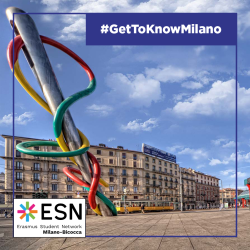[ENGLISH VERSION BELOW]
Alla fine degli anni ’90 piazzale Cadorna diventa uno dei nodi di scambio più trafficati di Milano. Questa crescita rese necessario un intervento di restyling urbano, che interessasse sia l’interno della stazione, che la piazza circostante, il progetto venne affidato all' architetto Gae Aulenti.
Questa la genesi dell’enorme scultura Ago, Filo e Nodo, inaugurata nel 2000.
Si tratta di una gigantesco ago da cucito attaccato a un filo di colori diversi (rosso, verde e giallo), che idealmente buca la piazza come fosse un tessuto, lasciando fuori il nodo (in corrispondenza della fontana) e riemergendo dall’altro lato, davanti alla stazione, pronto per imbastire un altro punto.
Una scultura alta ben 18 metri, realizzata in acciaio e vetroresina, ricco di significati simbolici. L’idea principale è quella del treno che passa in una galleria sotterranea, alludendo così alla metropolitana, i cui colori identificativi delle linee (rosso, verde e giallo) sono gli stessi del filo. Ma la scultura vuole anche essere un omaggio a una delle eccellenze milanesi, la moda, per cui la città è conosciuta in tutto il mondo, e alla laboriosità che la contraddistingue. Non da ultimo, come ha dichiarato la stessa Gae Aulenti, costituisce inoltre una parafrasi dello stemma della città di Milano, il biscione degli Sforza.
ENGLISH
At the end of the 90's Cadorna square became one of the most congested places of exchange in Milan. This growth brought to an intervention of urban restyling that interested both the inside of the station and the surrounding square, the project was assigned to the architect Gae Aulenti.
This is the genesis of the enormous sculpture Needle, Thread and Knot, inaugurated in 2000.
It is a gigantic needle attached to a thread of different colors (red, green and yellow), that ideally holes the square as if it were a fabric, leaving out the knot (in correspondence of the fountain) and resurfacing from the other side, in front of the station, ready to baste another point.
A 18 meters high sculpture, realized with steel and fiberglass and rich of symbolic meanings. The principal idea is that of a train that passes through an underground gallery, alluding to the subway, whose identifying colors of the lines (red, green and yellow) are the same ones of the Thread. The sculpture also represents a homage to one of the Milanese excellences, that is Fashion, for which the city is known all over the world, and to the laboriousness that characterizes it. Moreover, as the same Gae Aulenti has declared, it constitutes a paraphrase of the coat of arms of the city of Milan as well, that is the big grass snake of the Sforza.


Follow us